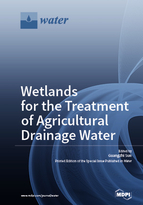Wetlands for the Treatment of Agricultural Drainage Water
A special issue of Water (ISSN 2073-4441). This special issue belongs to the section "Water Quality and Contamination".
Deadline for manuscript submissions: closed (31 May 2018) | Viewed by 50899
Special Issue Editor
Special Issue Information
Dear Colleagues,
Agricultural drainages, such as irrigation waters from paddy fields, often carry nutrients and pesticides that cause eutrophication and bioaccumulation of endocrine disruptors in receiving waterways. Seasonal factors can significantly affect the quantity, and sometimes quality, of these waters. While no water may be discharged from an agricultural land in many months of a year, a large quantity can be released during a short period of time, giving an excessive pollutant load on any pollution control/mitigation system. As a result, the management and treatment of agricultural drainages present a significant technical challenge. Worldwide, answers are being sought about: (a) the optimal apportionment of lands to production and conservation; (b) innovative management to prevent uncontrolled drainage discharge; and (c) cost-efficient and effective treatment technologies.
Considered kidneys of the Earth, wetlands have had their unique water purification function recognised, and used for pollution control, for centuries. In some major agriculture regions, such as Northeastern China, it is now recognized that wetlands are indispensable to water security, biodiversity, and regional environment. Efforts are being made to recover some natural wetlands from illegal crop fields. An increasing number of constructed wetlands are being built to treat various types of wastewaters and, somewhat, compensate for diminished natural wetland functions.
This Special Issue aims to present the latest research in the use of natural and constructed wetlands in agricultural drainage management. Papers may report: (1) the efficiency of constructed wetlands to remove various pollutants from agricultural drainages; (2) innovative management of drainage waters for the restoration of degraded wetlands and/or protection of water environment; (3) models relevant to agricultural water discharge to wetlands; and (4) the fates of agricultural pollutants in the wetlands.
Assoc. Prof. Guangzhi Sun
Guest Editor
Manuscript Submission Information
Manuscripts should be submitted online at www.mdpi.com by registering and logging in to this website. Once you are registered, click here to go to the submission form. Manuscripts can be submitted until the deadline. All submissions that pass pre-check are peer-reviewed. Accepted papers will be published continuously in the journal (as soon as accepted) and will be listed together on the special issue website. Research articles, review articles as well as short communications are invited. For planned papers, a title and short abstract (about 100 words) can be sent to the Editorial Office for announcement on this website.
Submitted manuscripts should not have been published previously, nor be under consideration for publication elsewhere (except conference proceedings papers). All manuscripts are thoroughly refereed through a single-blind peer-review process. A guide for authors and other relevant information for submission of manuscripts is available on the Instructions for Authors page. Water is an international peer-reviewed open access semimonthly journal published by MDPI.
Please visit the Instructions for Authors page before submitting a manuscript. The Article Processing Charge (APC) for publication in this open access journal is 2600 CHF (Swiss Francs). Submitted papers should be well formatted and use good English. Authors may use MDPI's English editing service prior to publication or during author revisions.
Keywords
- agricultural runoff
- constructed wetland
- water pollution control
- wetland restoration






